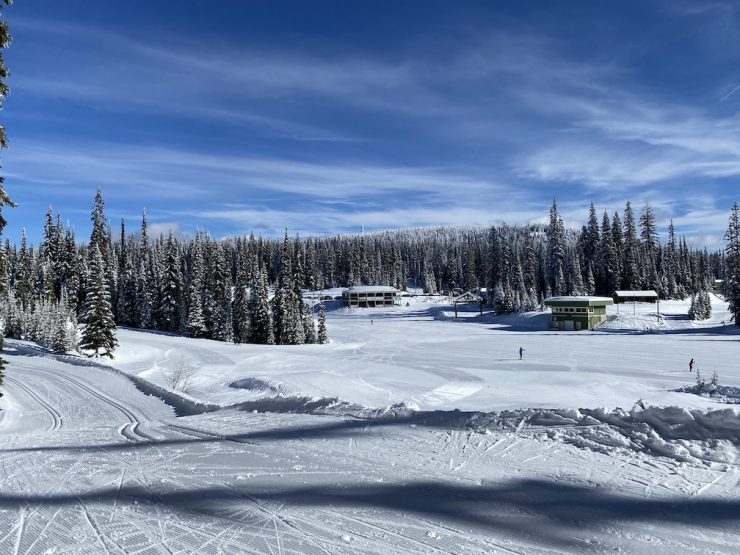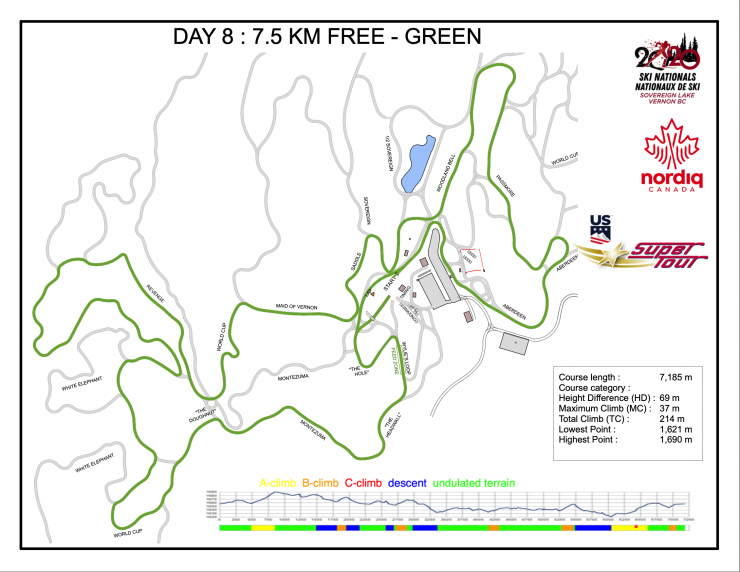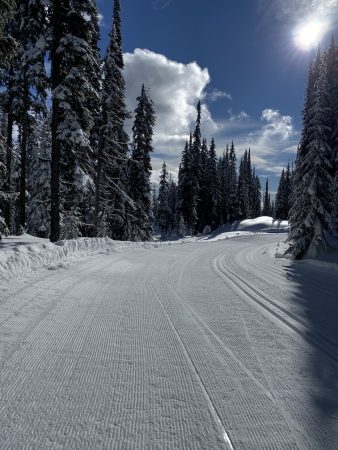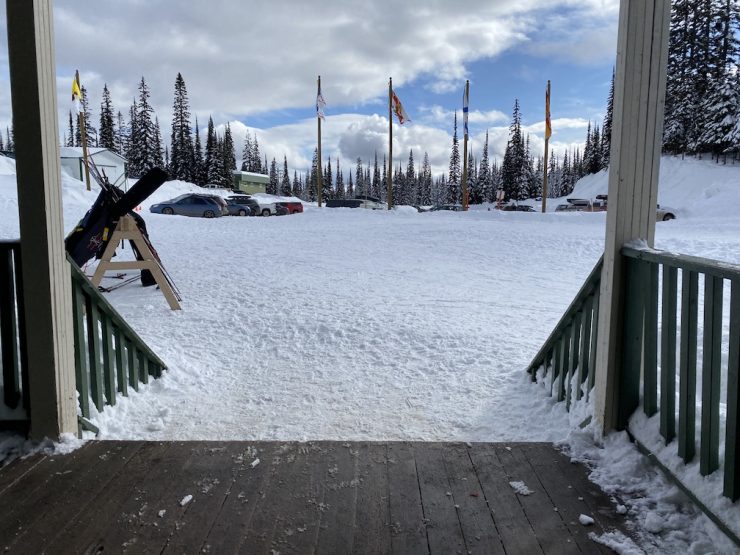
A middle of the pack master would have to be an idiot to sign up to race 50km against the best skiers in North America on a FIS-approved World Cup course. The top skiers will be fresh from World Cup Finals in Canmore and competing for important titles, national team selection, and future World Cup starts. With 2020 Nationals combined with US SuperTour Finals, the field will be deep. So why is my name on registration list?

The Sovereign Lake ‘West 7.5km’ loop is easy by World Cup standards. There are no long steady climbs like Canmore. There are no unending series of steep climbs like Holmenkollen. The ‘final four’ climb at Sov requires many transitions, but doesn’t have the bite of Val di Fiemme’s A climbs. There are no tricky downhills like Whistler Olympic Park. The Upper 2.5 is easier than the Upper 5 used at Norams. The Lower 5 is flatter than the Lower 2.5 and 3.75 that were used for the 2005 World Cup. Put those pieces together and the result is a loop that flows over small undulations with only two gentle A climbs and five rolling B climbs for 1,438m total climb over 49km. There won’t even be man-made snow or a narrow ribbon of trucked in snow. For elite skiers, it doesn’t get much easier than this: Day8-FIS_7.5km

By master’s standards, the course no longer looks gentle and forgiving. Pushing past the redline for a moment too long will result in seconds lost on every subsequent transition. Failing to push over the top will cost even more seconds.
So what kind of idiot would sign up to be lapped by the very same elite skiers he has been interviewing for eight seasons and timing for even longer?
Maybe the kind who celebrates making the top half of his age group in the local loppets. The kind who expects to lose a minute per kilometre to elite skiers on loppet courses, even when those skiers are just cruising in the pack for much of the race. The kind who bemoans less than perfect skis on race day because he doesn’t have the technique or engine to push past.
Maybe the kind who can’t let go of the fact that he couldn’t get it done when he was young and had endless training opportunities. Other people simply skied faster. Pierre Harvey and Donald Farley were six years on either side of me, and they are remembered because they delivered when the opportunity was there. Harvey has nothing to prove and can have fun skiing local events. I am still trying to prove something, possibly that I still have relevance on SlowerSkier.com, where it is all about getting more time on course for your money.
Maybe the kind who didn’t get to race Nationals at his hometown club as a junior because BC decided to give starts to only the top four skiers in each age group.
At the end of the analysis, I know better. I laughed at the idea that I would ever join the Canadian tradition of having some podgy middle-aged man start the 50km to show just how big the gap to elite is. And then one sunny summer intensity day on a dusty trail with the masters group, my coach told me I should enter: “If you work hard this year, you will only be lapped once.” And then my mouth said yes while my brain was screaming no.
On April 2nd, look for me chasing that reverse podium, seven (7) times up that final four climb carrying the lanterne rouge.
This video is from April 7th, 2019, with a below normal snowpack for April. 2020 is looking to be better.
Most xc skiers are nice people, even the top racers. Does this have something to do with getting your ego handed to you in travel-sized pieces on a fairly regular basis? And if so, will I be a better person on April 3rd?
To start at Nationals, a Canadian skier simply needs a CCC license and points on the Canadian Points List, a new requirement introduced in 2019. As the CPL will be updated after the World Cup Final in Canmore, there is still time to improve your ranking, which uses the average of the best 7 Tier 2 or higher results in the last 12 months. While all races are technically open to qualified masters, only the long mass start is really friendly to older athletes (30km for women, 50km for men).
Non-Canadian skiers need active FIS points, which are automatically included in the CPL. Should Alexander Bolshunov decide to show up for a week of natural snow, he will be seeded first.
Please note that if you sign up without both a valid license and active points, the host club will thank you for your donation but Nordiq Canada will not allow you to start.
As I just renewed my license after a 36 year lapse, I will be skiing in the open category at BC Championships on the Telemark trails in March to earn some points. It is possible that the masters category will be assigned points at select Tier 2 events (as a separate wave), but the only safe bet is registering in the open category.
My three digit CCC license number looks a little out of place on the registration list where most of the athletes have numbers above 30,000.
Fun fact about aging: My retirement race was 1984 BC Championships, also at Telemark Trails. This was the first time I used two skate (aka V2 alternate in the USA, skate 3 in Scotland, and gear 4 for HC Holmberg) during a points race.
1984 was near the end of the golden age of ski racing. Classic racing had not yet been invented and the marathon skate dominated all. We were still using a short section of kick wax as that was essential to be competitive on the steeper climbs. There was no internet and no YouTube. We only saw skiers on TV every four years at the Olympics, but didn’t record it because VCR’s were too expensive for home use. There were also no mass starts other than relays.
One of my teammates, who was also one of the first victims of my coaching, was trying hard to push his limits and started us down a path to figure out a way to add poling to speed skating technique. Once we had the basics down, Joe would shout ‘Gaétan Boucher’ with a dubious French accent anytime he found a trail wide enough and firm enough to use it on. (This was just after the 1984 Olympics where a Canadian named Gaétan Boucher had dominated the speed skating events.) In this era, most courses were set by snowmobile, not snowcat, and often the only snow firm enough to plant a pole was the edge of the classic track.
It wasn’t until the final race of the season, and the final race of my career, that opportunity knocked. Joe won his age group in dominating style and I finished 5th in mine. It would have been my best result of the season, but the guys who had just barely beaten me all season started 30 and 60 seconds behind me and got the split information they needed to close the gap over the final 3km.
This new ‘out of the tracks’ skating would get a (confusing but official) name the next season and be joined by ‘one skate’ (aka V2 in the USA, skate 2 in Scotland, and gear 3 by HC Holmberg). For Christmas in 1985, Joe came back from a national team camp and taught me the final piece of the puzzle, a new climbing technique called ‘offset’, just like paddling a canoe. Suddenly, skating was possible on every steep hill and grip wax was gone forever. Best Christmas present ever.




